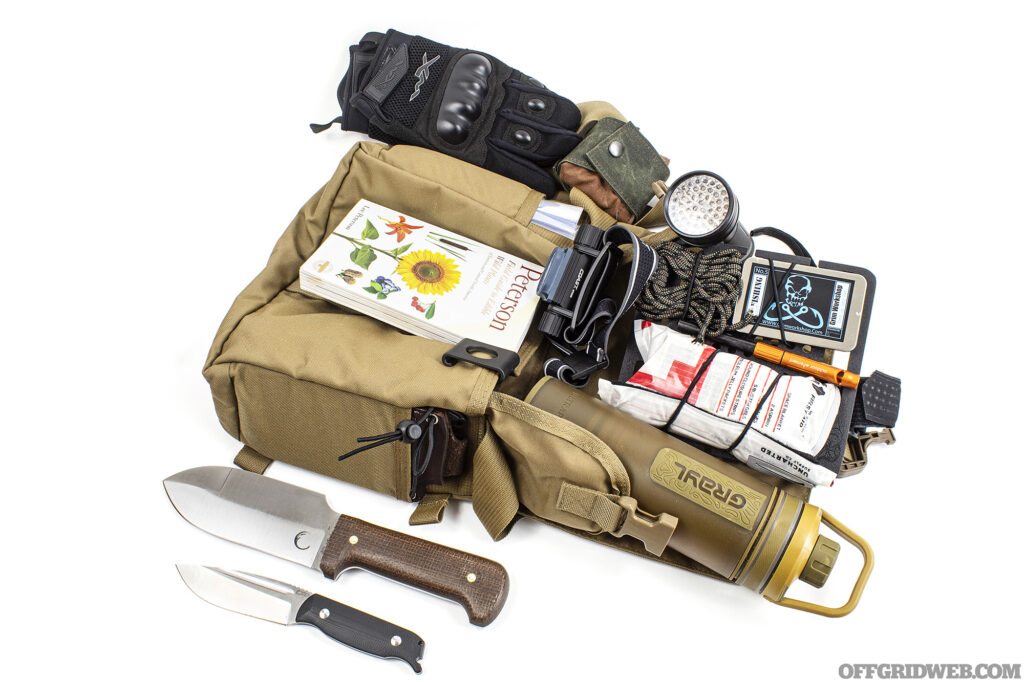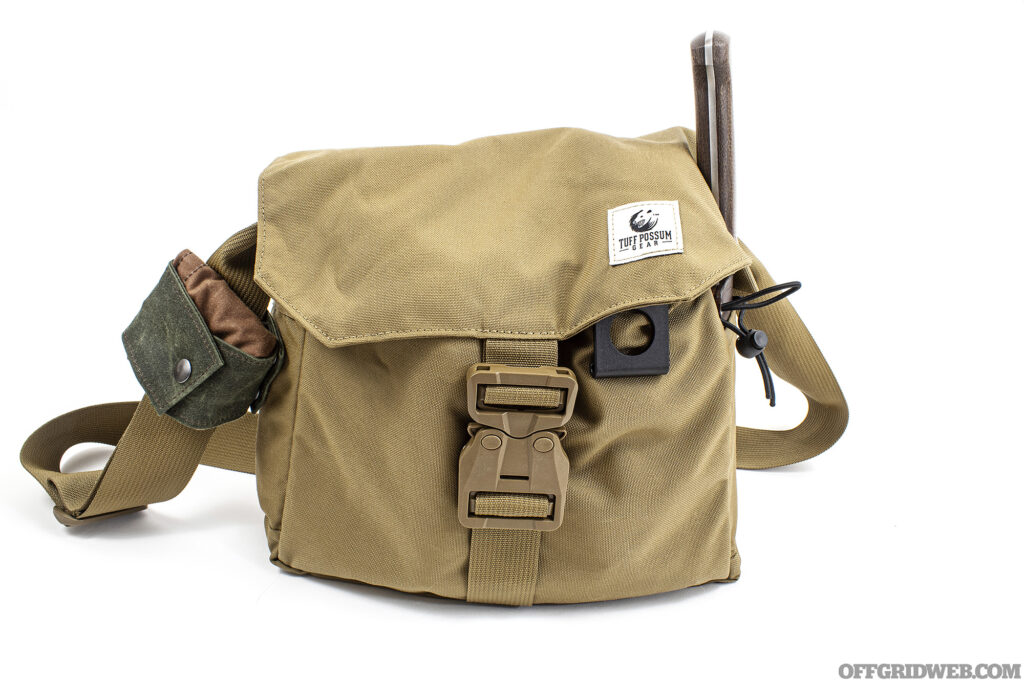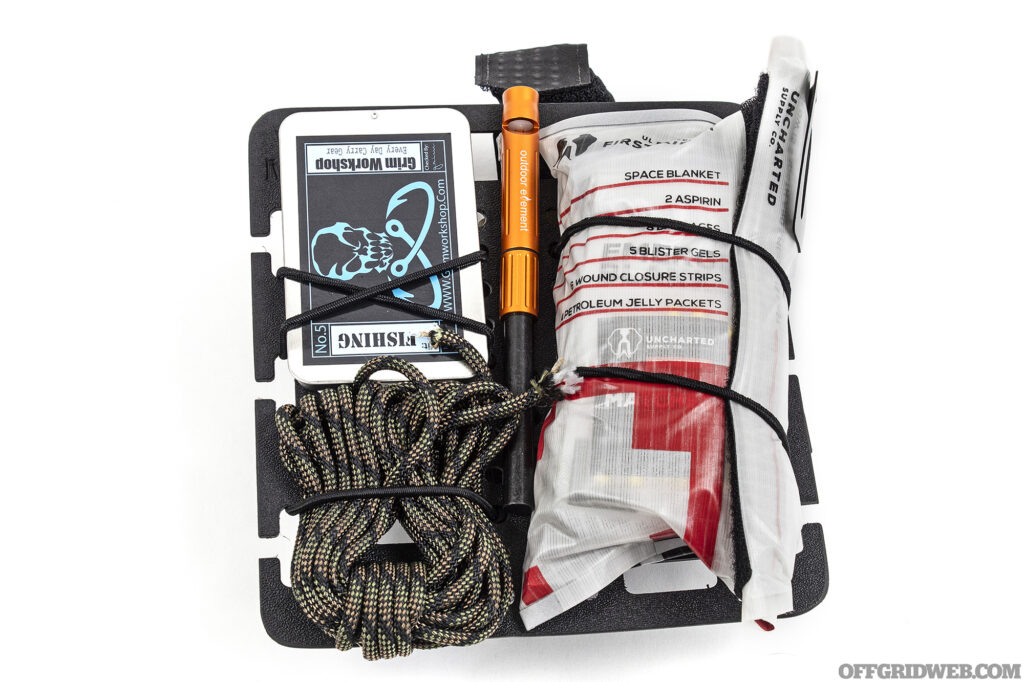Right now, no matter where you are, chances are you’re surrounded by useful natural resources. From the deepest wilderness to the inner city, nature provides a treasure trove of flavors and nutrients, waiting to be discovered by the adventurous forager. Whether you’re a seasoned wild food enthusiast or a curious beginner, having the right gear is essential for a successful foraging expedition. What you pack is highly dependent on what your personal situation is. This foraging satchel is focused on roots and other items low to the ground like flowers, berries, and mushrooms. Remember, foraging is not just about taking; it’s about understanding and respecting what nature can provide. Always forage responsibly and try to start out with an experienced guide who can help you on your journey.

The Bag: Tuff Possum’s Shackleton
When it comes to foraging, you need a bag that’s rugged and versatile. The Shackleton EDC Satchel, inspired by the legendary Antarctic explorer Ernest Shackleton, is a practical companion for gathering wild resources. Its adjustable ITW Cobra buckle closure ensures quick and easy access, even with one hand. The slip pockets on either end hold essential tools like flashlights or folding saws — or in this case, the Wild Harvest Foraging Tool by LT Wright Knives — making them readily available. Inside, the PALS pattern loop panel offers modular organization for various tools and containers. The secondary weather flaps with ITW side release buckles offer protection against the elements, ensuring the contents remain dry and secure.
The satchel’s compact size, 12 by 9 by 4 inches, and weight of just 1.2 pounds make it a convenient choice for carrying small tools or collected resources. When you need to carry more gear, it can be buckled onto to hiking backpacks via four 1-inch mounting loops.

Satchel Contents
Foraging Tools: Foraging isn’t just about picking; it’s about harvesting with care and precision. Les Stroud’s Wild Harvest Foraging Tool is a specialized knife designed for the task. With its unique blade shape and ergonomic handle, it allows you to cut, dig, and pry. Designed from the traditional Hori-Hori, and crafted with 5/32-inch A2 tool steel, it’s saber-ground with a false clip, allowing it to plunge effortlessly into the earth. The steel choice also offers corrosion resistance and ease of field sharpening.
An additional CJRB knife for work requiring a little more finesse is secured to the opening of the satchel. The CJRB Hyperlite is a 4-inch fixed blade that only weighs 3.5 ounces. Made from Artisan Cutlery’s proprietary AR-RPM9 steel, it’s durable and easy to keep sharp. It’s also a blade that won’t break the bank if it needs to be replaced.
Foraging Pouches: Collecting wild edibles requires containers that are both sturdy and accessible. PNW Bushcraft’s Waxed Canvas Foraging Pouch is great for this. Its waxed canvas material is resistant to the elements, and its hip-bag design ensures your finds are always within reach. Equipped with two sturdy snaps, the pouch easily clips onto belts up to 2 inches wide, leaving your hands free to collect. It also makes it easy to affix to the shoulder strap of the Shackleton. It’s the perfect size to hold a variety of items, from fire-starting materials to wild edibles and more. Hand sewn into the bottom is a durable mesh panel that’s great for allowing mushroom spores to scatter and provides a soft resting place for eggs or berries. When not in use, it simply folds up and snaps closed, becoming virtually unnoticeable.
The Wazoo Gear Foraging Bandana is another asset. It measures 22 inches across and is covered in detailed illustrations of the 12 most common wild plants and fungi of North America. These illustrations also indicate the field uses of all 12 plants and fungi, and each bandana includes 5 Steps of Identifying Edible Plants by Samuel Thayer and Rules and Ethics of Foraging by Mark Vorderbruggen. These insights have been carefully curated in cooperation with renowned experts like Dr. Nicole Apelian, ensuring that the information is both accurate and useful.
First Aid Kit: Safety first. A compact first aid kit is essential for treating minor injuries or allergic reactions in the field. This kit has an Uncharted Supply Co. first aid kit (includes a space blanket, aspirin, bandages, blister gel, Steri-Strips, and petroleum jelly) secured to a Woods Monkey Monkey Board for efficient organization and ease of access. On the back, a Viper Kydex tourniquet holster keeps a life-saving tourniquet easily accessible. Whether it’s used for fun or as a source of emergency sustenance, a Grim Workshop fishing kit is secured to the board. The kit also includes an Outdoor Element Fire Flute in case starting a fire or signaling for help might be needed. To round it out, there’s about 20 feet of Survivor Cord, which is similar to paracord, but has strands of snare wire, fishing line, and fire-starting cord along with the normal paracord “guts.”

Headlamp: Foraging doesn’t have to stop when the sun goes down. A quality headlamp will illuminate your path on your way back home or light up dark recesses for hands-free access. Coast makes some very affordable headlamps, and the one I have in the foraging satchels has a few settings that are great for a wild edible hunt, such as: a red light option and an emergency strobe.
Wild Edible Field Guides: One of the first things you learn as a beginner forager, is that many edible species have poisonous doppelgangers. Carrying field guides can help mitigate the risk of accidentally picking the wrong plant.
Note-Taking Supplies: Easy-to-use phone cameras have changed many dynamics about foraging but documenting your finds with a waterproof notebook and pen — especially where a plant was found and its growing conditions — can help when researching whether or not it’s safe to consume. It’s a great way to track your progress and share your knowledge with others in places where cell signals may be lacking.

Gloves: Protect your hands from thorns and rough terrain with a pair of durable gloves. Wiley X Durtac gloves keep hands safe from knuckle busting rocks, deadfall, or other debris.
Extra Bags: You never know how bountiful your harvest might be. Carry extra bags to ensure you have enough space for all your finds.
UV Light: Some of the most sought-after foraged goods have a unique tell that gives them away. Morels and other foraging items can fluoresce under UV light. Carry a UV flashlight to uncover these hidden gems.
Foraging Satchel Make and Model
Shackleton EDC Satchel
URL: tuffpossumgear.com
Read More
Don't forget to subscribe to our free newsletter for more content like this.
- The Legendary Survival Story of Sir Ernest Shackleton
- Hidden Dangers of AI Written Foraging Guides on Amazon
- The Foraging Myth of Subsisting on Nothing More than Wild Plants
- Urban Foraging: Food is Everywhere
- Infographic: A Survivalist's Guide to Wild Edible Plants
The post Foraging Satchel: A Compact Bag For Identifying And Collecting Wild Edibles appeared first on RECOIL OFFGRID.
By: Patrick Diedrich
Title: Foraging Satchel: A Compact Bag For Identifying And Collecting Wild Edibles
Sourced From: www.offgridweb.com/gear/foraging-satchel-a-compact-bag-for-identifying-and-collecting-wild-edibles/
Published Date: Mon, 23 Oct 2023 17:01:29 +0000
-------------------------------------------------------------------------
Did you miss our previous article...
https://outdoorsnewswire.com/survivalist/are-tasers-legal-in-colorado-what-you-should-know
 CampingSurvivalistHuntingFishingExploringHikingPrivacy PolicyTerms And Conditions
CampingSurvivalistHuntingFishingExploringHikingPrivacy PolicyTerms And Conditions
